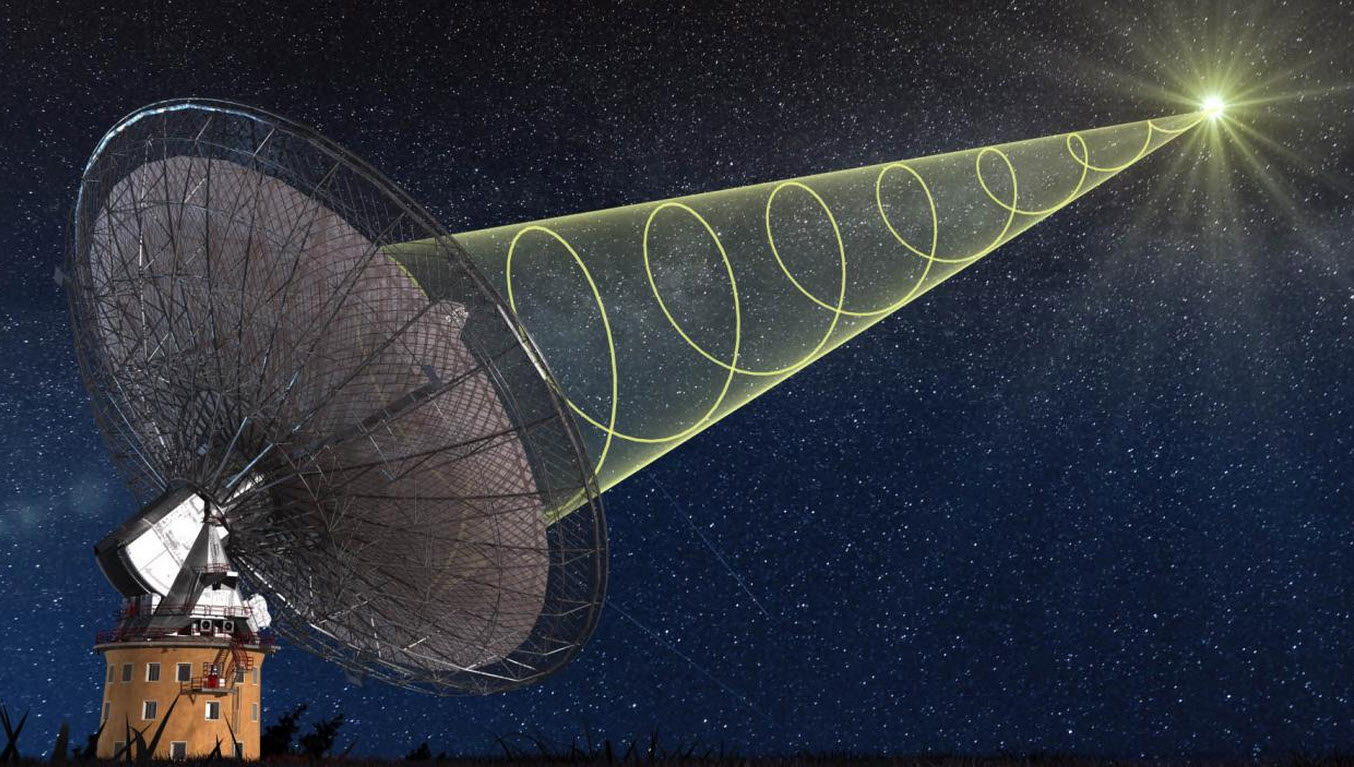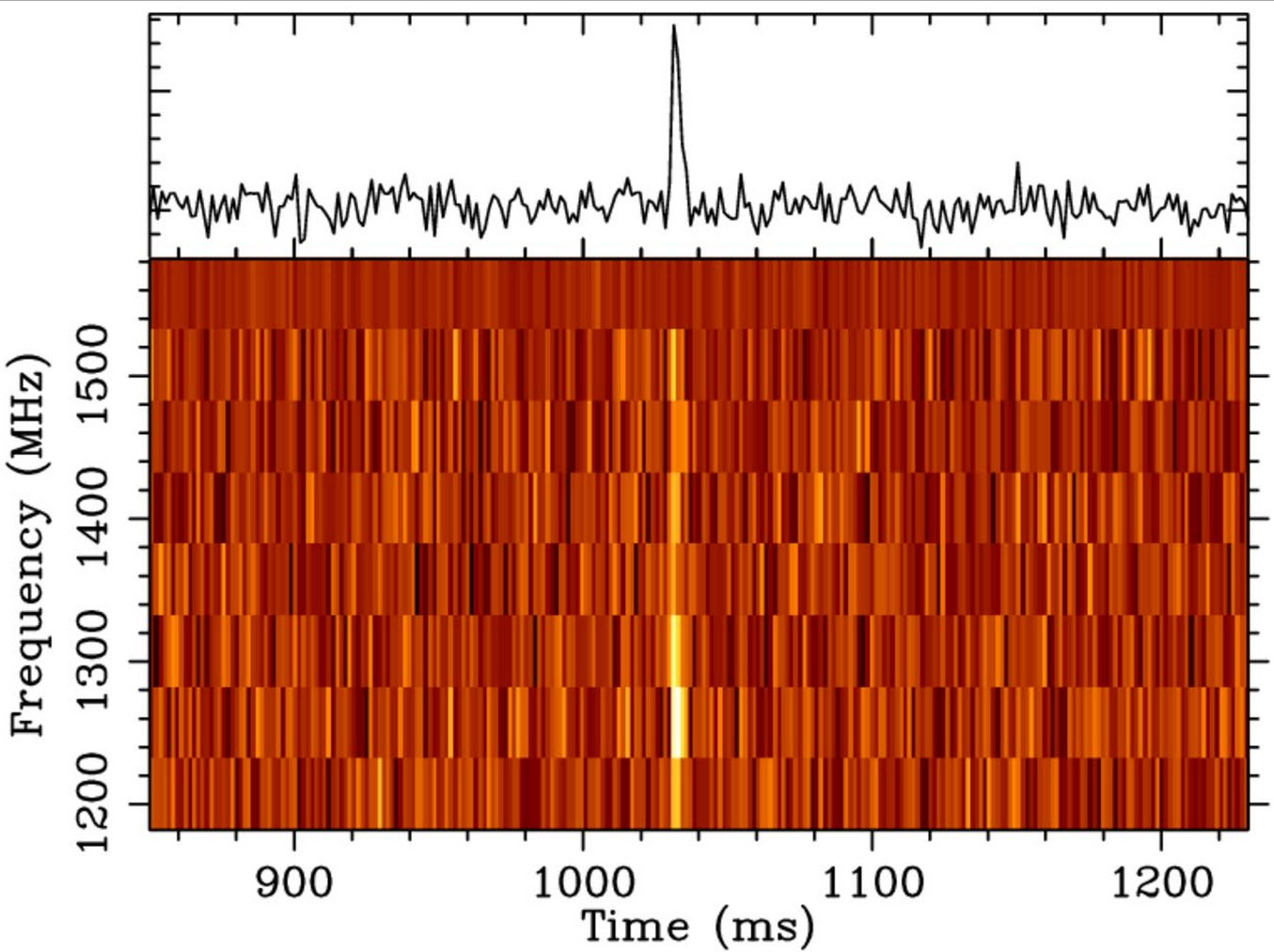Mysterious cosmic burst of radio waves detected by astronomers
January 20, 2015

Illustration of CSIRO’s Parkes radio telescope receiving a (partially) circular-polarized microwave radio signal “fast radio burst” from an unknown source 5.5 billion light years away (credit: Swinburne Astronomy Productions)
On May 14, 2014, astronomers at Parkes Radio Telescope led by Emily Petroff at Swinburne University of Technology observed live an extremely short, sharp “fast radio burst” for 2.8 milliseconds at a microwave frequency of 1.4 GHz from an unknown source at an estimated distance of up to 5.5 billion light years from Earth. 24 seconds later, an email alert went out to astronomers at 12 telescopes around the world to make follow-up observations on other frequencies, ranging from infrared and visible light to ultraviolet light and X-ray waves.
However, no further signals were found, the astronomers reported Monday (Jan. 19) in an open-access paper in Monthly Notices of the Royal Astronomical Society. But when astronomers went through archival data from the Parkes Radio Telescope (famous for its role in the movie The Dish — technical corrections here) in Eastern Australia, they found that the pulse had already been detected by chance in 2007.
Astronomers also found six more such unnoticed bursts in the Parkes telescope’s data and a seventh in Arecibo telescope data.

Pulse profile (top) and dynamic spectrum (orange-yellow) of FRB 140514. Communications satellites operating in the 1525–1559 MHz band prevented observations there. (Credit: E. Petroff et al./Mon. Not. R. Astron. Soc)
So what did they discover? “The burst could have hurled out as much energy in a few milliseconds as the Sun does in an entire day,” explains paper co-author Daniele Malesani, an astrophysicist at the Dark Cosmology Centre, Niels Bohr Institute, University of Copenhagen.
“But the fact that we did not see light in other wavelengths eliminates a number of astronomical phenomena that are associated with violent events, such as gamma-ray bursts from exploding stars and supernovae, which were otherwise candidates for the burst.”

The electromagnetic spectrum. For the study of fast radio bursts, scientists looked for radio waves with the Parkes telescope, then X-rays with the Swift satellite, and then optical light with the Nordic Optical Telescope, among others. (Credit: Niels Bohr Institute)
But the burst did leave another clue. The Parkes detection system captured the polarization of the light. Polarization is the direction in which electromagnetic waves oscillate and they can be linearly or circularly polarized. The signal from the radio wave burst was about 21 percent circularly polarized, which suggests that there was a magnetic field in the vicinity, the astronomers suggest.
“The theories are now that the radio wave burst might be linked to a very compact type of object — such as neutron stars or black holes — and the bursts could be connected to collisions or ‘star quakes.’ Now we know more about what we should be looking for,” says Malesani.
Abstract of A real-time fast radio burst: polarization detection and multiwavelength follow-up
Fast radio bursts (FRBs) are one of the most tantalizing mysteries of the radio sky; their progenitors and origins remain unknown and until now no rapid multiwavelength follow-up of an FRB has been possible. New instrumentation has decreased the time between observation and discovery from years to seconds, and enables polarimetry to be performed on FRBs for the first time. We have discovered an FRB (FRB 140514) in real-time on 2014 May 14 at 17:14:11.06 UTC at the Parkes radio telescope and triggered follow-up at other wavelengths within hours of the event. FRB 140514 was found with a dispersion measure (DM) of 562.7(6) cm−3 pc, giving an upper limit on source redshift of z ≲ 0.5. FRB 140514 was found to be 21 ± 7 per cent (3σ) circularly polarized on the leading edge with a 1σ upper limit on linear polarization <10 per cent. We conclude that this polarization is intrinsic to the FRB. If there was any intrinsic linear polarization, as might be expected from coherent emission, then it may have been depolarized by Faraday rotation caused by passing through strong magnetic fields and/or high-density environments. FRB 140514 was discovered during a campaign to re-observe known FRB fields, and lies close to a previous discovery, FRB 110220; based on the difference in DMs of these bursts and time-on-sky arguments, we attribute the proximity to sampling bias and conclude that they are distinct objects. Follow-up conducted by 12 telescopes observing from X-ray to radio wavelengths was unable to identify a variable multiwavelength counterpart, allowing us to rule out models in which FRBs originate from nearby (z < 0.3) supernovae and long duration gamma-ray bursts.